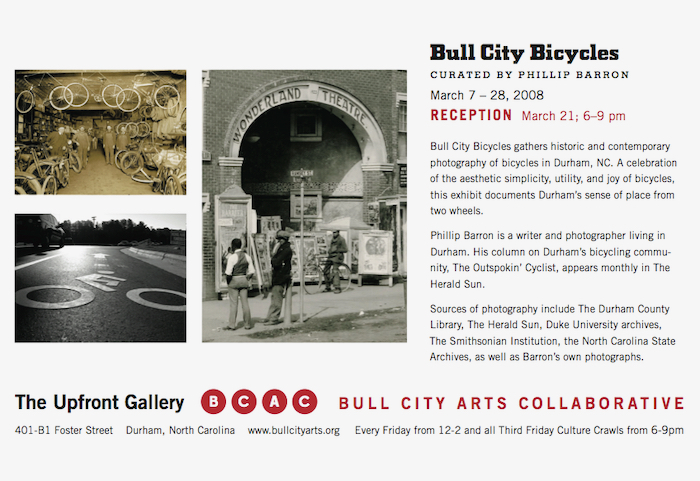March 7 – 28, 2008, the exhibit Bull City Bicycles gathers historic and contemporary photography of bicycles in Durham, North Carolina. A celebration of the aesthetic simplicity, utility, and joy of bicycles, this show documents Durham’s sense of place from two wheels.
Durham has a culturally rich history, beginning with its role as an early hub of the post-Civil War tobacco industry. There later developed an adjacent (eventually annexed) locale that, according to W.E.B. DuBois was a rich example of a separate and thriving residential and business community run entirely by African-Americans — the Hayti community. Hayti’s fame and financial success led its entrepreneurs to establish some of the first national African-American owned insurance and banking organizations. As a result, a part of downtown Durham was later dubbed Black Wall Street.
Much of this history has been lost to Urban Renewal and subsequent neglect of historic properties. Bull City Bicycles includes film and photography from both Durham and Hayti, from existing and forgotten communities.
Barron, curator of Bull City Bicycles, is a writer and photographer living in Durham. His column on Durham’s bicycling community, “The Outspokin’ Cyclist,” appears monthly in The Herald Sun.
Trained in analytic philosophy, Barron uses the conceptual accessibility of the bicycle as a focal point for discussing a variety of subjects of contemporary importance. The history of Durham’s cycling community is a palimpsest of race, urban planning, political activism, environmentalism, and freedom. Barron is currently at work researching thishistory.
In the 1880s, B.L. Duke and Company’s furniture store rented high wheelers (the bikes with a front wheel nearly as tall as the rider and much smaller rear wheel) for ten cents an hour. Renting bicycles was a popular form of entertainment in late 19th century Durham.
As early as 1890, women began cycling in Durham. The sartorial reform that accompanied women cycling challenged traditional gender norms in Durham as elsewhere, and made the bicycle literally and metaphorically a vehicle of social change.
The stories of Durham’s cycling community are necessarily intertwined with the stories of transit and transportation planning in Durham. Durham’s urban landscape developed around horse and buggy, railroads, trolley cars, automobiles, buses, and eventually the removal of the trolleys. In recent years bicyclists have moved from the margins of unaccommodating roadways to become effective advocates within City Hall for bike lanes and inclusive urban planning. Bull City Bicycles tells a story about our relationship to space, our use of land, and the kind of community we hope to build and can expect to grow from our land-use decisions.
Sources of photography include The Herald Sun, The Durham County Library, The Rare Book, Manuscript, and Special Collections Library at Duke University, The Smithsonian Institution, the North Carolina State Archives, as well as curator Phillip Barron’s own photographs.
Contact the gallery:
Dave Wofford (919.949.4847, Horse & Buggy Press)
































